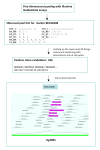A new implementation of high-throughput five-dimensional clone pooling strategy for BAC library screening
- PMID: 21129228
- PMCID: PMC3016418
- DOI: 10.1186/1471-2164-11-692
A new implementation of high-throughput five-dimensional clone pooling strategy for BAC library screening
Abstract
Background: A five-dimensional (5-D) clone pooling strategy for screening of bacterial artificial chromosome (BAC) clones with molecular markers utilizing highly-parallel Illumina GoldenGate assays and PCR facilitates high-throughput BAC clone and BAC contig anchoring on a genetic map. However, this strategy occasionally needs manual PCR to deconvolute pools and identify truly positive clones.
Results: A new implementation is reported here for our previously reported clone pooling strategy. Row and column pools of BAC clones are divided into sub-pools with 1~ 2 x genome coverage. All BAC pools are screened with Illumina's GoldenGate assay and the BAC pools are deconvoluted to identify individual positive clones. Putative positive BAC clones are then further analyzed to find positive clones on the basis of them being neighbours in a contig. An exhaustive search or brute force algorithm was designed for this deconvolution and integrated into a newly developed software tool, FPCBrowser, for analyzing clone pooling data. This algorithm was used with empirical data for 55 Illumina GoldenGate SNP assays detecting SNP markers mapped on Aegilops tauschii chromosome 2D and Ae. tauschii contig maps. Clones in single contigs were successfully assigned to 48 (87%) specific SNP markers on the map with 91% precision.
Conclusion: A new implementation of 5-D BAC clone pooling strategy employing both GoldenGate assay screening and assembled BAC contigs is shown here to be a high-throughput, low cost, rapid, and feasible approach to screening BAC libraries and anchoring BAC clones and contigs on genetic maps. The software FPCBrowser with the integrated clone deconvolution algorithm has been developed and is downloadable at http://avena.pw.usda.gov/wheatD/fpcbrowser.shtml.
Figures




Similar articles
-
A high-throughput strategy for screening of bacterial artificial chromosome libraries and anchoring of clones on a genetic map constructed with single nucleotide polymorphisms.BMC Genomics. 2009 Jan 18;10:28. doi: 10.1186/1471-2164-10-28. BMC Genomics. 2009. PMID: 19149906 Free PMC article.
-
Screening of a Brassica napus bacterial artificial chromosome library using highly parallel single nucleotide polymorphism assays.BMC Genomics. 2013 Sep 6;14:603. doi: 10.1186/1471-2164-14-603. BMC Genomics. 2013. PMID: 24010766 Free PMC article.
-
Genetic marker anchoring by six-dimensional pools for development of a soybean physical map.BMC Genomics. 2008 Jan 22;9:28. doi: 10.1186/1471-2164-9-28. BMC Genomics. 2008. PMID: 18211698 Free PMC article.
-
A BAC pooling strategy combined with PCR-based screenings in a large, highly repetitive genome enables integration of the maize genetic and physical maps.BMC Genomics. 2007 Feb 9;8:47. doi: 10.1186/1471-2164-8-47. BMC Genomics. 2007. PMID: 17291341 Free PMC article.
-
Sex chromosome evolution in amniotes: applications for bacterial artificial chromosome libraries.J Biomed Biotechnol. 2011;2011:132975. doi: 10.1155/2011/132975. Epub 2010 Oct 12. J Biomed Biotechnol. 2011. PMID: 20981143 Free PMC article. Review.
Cited by
-
Consolidation of the genetic and cytogenetic maps of turbot (Scophthalmus maximus) using FISH with BAC clones.Chromosoma. 2014 Jun;123(3):281-91. doi: 10.1007/s00412-014-0452-2. Epub 2014 Jan 29. Chromosoma. 2014. PMID: 24473579
-
Genome-wide SNP discovery in walnut with an AGSNP pipeline updated for SNP discovery in allogamous organisms.BMC Genomics. 2012 Jul 31;13:354. doi: 10.1186/1471-2164-13-354. BMC Genomics. 2012. PMID: 22849334 Free PMC article.
-
Advances in BAC-based physical mapping and map integration strategies in plants.J Biomed Biotechnol. 2012;2012:184854. doi: 10.1155/2012/184854. Epub 2012 Feb 27. J Biomed Biotechnol. 2012. PMID: 22500080 Free PMC article. Review.
-
Intergenomic single nucleotide polymorphisms as a tool for bacterial artificial chromosome contig building of homoeologous Brassica napus regions.BMC Genomics. 2014 Jul 4;15(1):560. doi: 10.1186/1471-2164-15-560. BMC Genomics. 2014. PMID: 24996518 Free PMC article.
-
Effective BAC clone anchoring with genotyping-by-sequencing and Diversity Arrays Technology in a large genome cereal rye.Sci Rep. 2018 May 30;8(1):8428. doi: 10.1038/s41598-018-26541-y. Sci Rep. 2018. PMID: 29849048 Free PMC article.
References
-
- Gardiner J, Schroeder S, Polacco ML, Sanchez-Villeda H, Fang Z, Morgante M, Landewe T, Fengler K, Useche F, Hanafey M. et al.Anchoring 9,371 maize expressed sequence tagged unigenes to the bacterial artificial chromosome contig map by two-dimensional overgo hybridization. Plant Physiol. 2004;134(4):1317–1326. doi: 10.1104/pp.103.034538. - DOI - PMC - PubMed
Publication types
MeSH terms
Substances
LinkOut - more resources
Full Text Sources
Other Literature Sources

